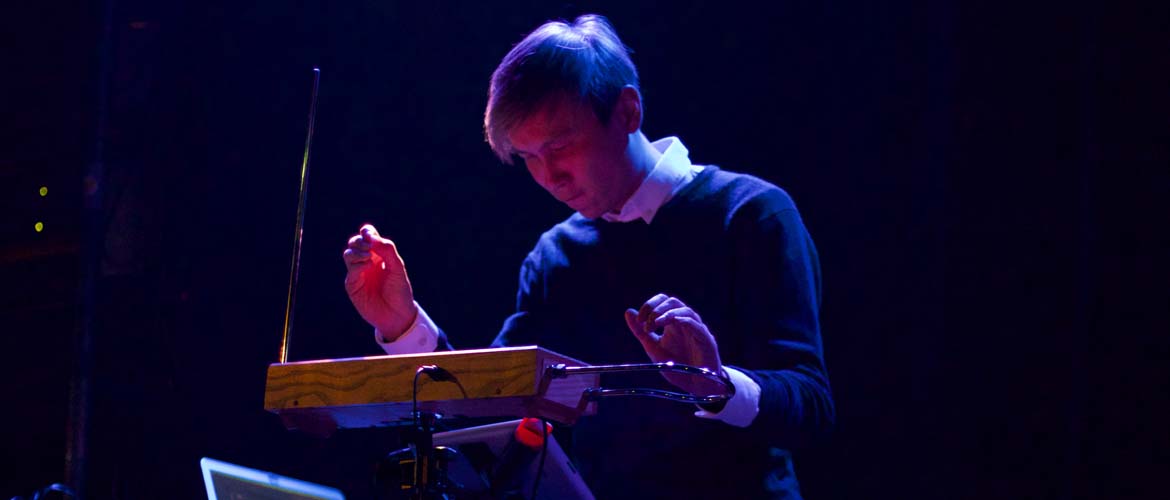The Collision of Technology and Sound
Before there were sophisticated musical instruments born of modern technology, there was the theremin. Su Aziz chats with a thereminist to discover more about the world’s first ever electronic music instrument. This article was published in the second edition of In Focus magazine.
The next time you watch an old school American science fiction film or listen to Good Vibrations by the Beach Boys, take note of a reedy, eerily ethereal sound in the background. That distinct, goosebump-producing sound is produced by the first ever electronic musical instrument invented by a Russian, two years after World War I. The year was 1920, the inventor was Leon Theremin and the industry-changing instrument was the theremin. Also known as thereminvox and etherophone.
‘The theremin,’ confirms Ng Chor Guan, internationally acclaimed Malaysian theremin player, ‘is the very first electronic instrument being invented in the world.’ The sounds it produces by are purely basic electronic sounds. ‘With it, you get boundless possibilities and the room for extraordinary imagination,’ he says.
First, Meet the Instrument
As explained by Encyclopaedia Britannica, what a theremin really is, is that it’s ‘made out of a box with radio tubes producing oscillations at two sound-wave frequencies above the range of hearing – together, they produce a lower audible frequency equal to the difference in their rates of vibration.’
Its pitch, the encyclopaedia clarifies, ‘is controlled by moving the hand or a baton toward or away from an antenna at the right rear of the box. This movement alters one of the inaudible frequencies. Harmonics, or component tones, of the sound can be filtered out, allowing production of several tone colours over a range of six octaves.’
Chor Guan describes the theremin as one of the most basic electronic instruments. Technology is used only to enhance the composed musical piece and to create special effects with the theremin. ‘There are already other instruments that have been inspired or based on the theremin, the closest being the ondes-Martenot, the electro-theremin and the persephone, just to name a few,’ he adds.
Now, Meet the Thereminist
37-year old Chor Guan has been a thereminist ever since it captivated him. ‘It was the way of playing
the instrument, in the air without any physical contact. Yet, precise movements of the hand,’ he confesses. That was in 2009. The instrument reminded him of his childhood dream of becoming an astronaut. ‘It’s the way you play a theremin – [fingers] hovering above the instrument, gives me an image of an astronaut floating in zero gravity,’ he adds.
In less than a decade, Chor Guan produced 11 albums, his film music had won multiple international awards, he was invited as musical director of DanceNorth Australia, participated in OneBeat by the government of the United States and was selected by Austrian Ministry of Culture for a 3-month residency programme in Vienna. The latter gave him an opportunity to give a lecture in Academy of Fine Arts, Vienna. Back in Malaysia, he’s a guest lecturer at Universiti Malaya.
Chor Guan’s resume as a musician and composer is undoubtedly impressive. He and his, now, 8-year old theremin are going places.
Confessions of a Thereminist
Chor Guan, trained in classical composition, have been composing pure orchestral pieces that are acoustically performed but he’s fully in the present when it comes to modern technology. ‘I’m well equipped with the knowledge of
both acoustic composition and technology,’ he adds. However, it’s combining both technology and humanity is his approach to reflect the current society and also to archive the era.
‘I really enjoyed having a dance-music improvisation session. In particular, with the dancers of Tanztheater Wuppertal Pina Bausch, Germany,’ he confesses. ‘What interests me about them is their creativity of connecting through body movements and music, which are both the fundamental elements of human instinct, even before the development of language. It is this language that we practice on a daily basis to express ourselves in our respective fields.’
Chor Guan admits to countless of his compositions that feature the theremin. ‘It’s challenging to count due to the sheer volume of pieces I’ve composed over the years. I’ve been performing around the world, including my many scored compositions as well as all the instinctive improvisations sessions,’ he says. ‘My favourite piece has to be Space Age. It’s currently on a world tour. The piece was materialised back in 2010. The restage of this, Space Age: The Phantom Power premiered in 2013 with new visuals.’
For him, Space Age evokes a time from when he was a child. ‘My dream was to become an astronaut. So, it’s a dream come true to be able to bring the audience through this transformative piece in an immersive experience of travelling to outer space. It gives the audience room for imagination and thinking outside of conventional means,’ Chor Guan confesses.
What’s Next?
‘A couple of projects are still on- going,’ Chor Guan confirms. ‘Significantly, Project 2020. It’s a 5-year project discussing the future, time and change, as well as being its agent. This project revolved around the integration of science and art in a live performance which debuted in 2015. The work features ideas of multiverse theory, perfect vision and the visionary, clones and time machines. Simultaneously, there are initiatives involving public participation such as roundtable talks, a series of forum-like sessions with a focus on profession and individual strength. Project 2020 offers the audience or participants new ways of accessing the future while moving towards better futures, real and imagined,’ he concludes.
Chor Guan will be in Malta in May 2018 for an artist residency and a scheduled performance for the closing ceremony of a festival in Malta. This is in conjunction with title of European Capital of Culture 2018 bestowed upon Valletta, the capital city of Malta.
___________________
For more on the latest topics related to business, technology, finance and more, read our digital versions of In Focus magazine, issue 1, issue 2 and issue 3.





